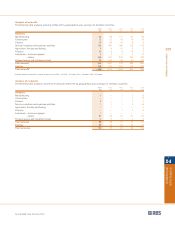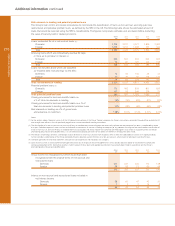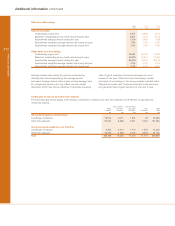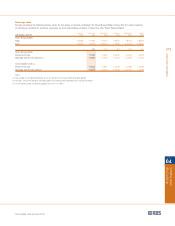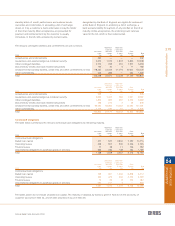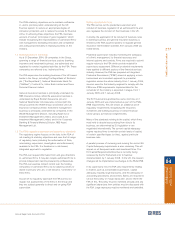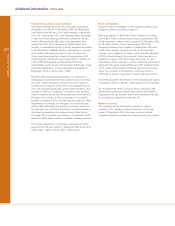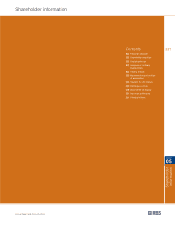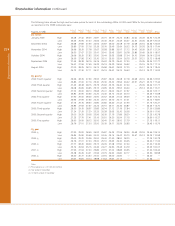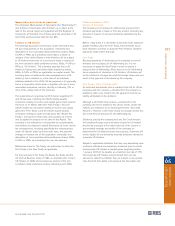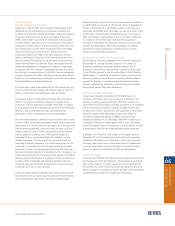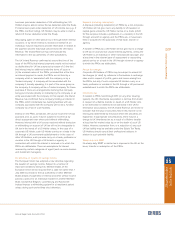RBS 2004 Annual Report Download - page 221
Download and view the complete annual report
Please find page 221 of the 2004 RBS annual report below. You can navigate through the pages in the report by either clicking on the pages listed below, or by using the keyword search tool below to find specific information within the annual report.
section
04
219
Annual Report and Accounts 2004
Additional information
Additional
information
1.9 The European dimension
An increasing amount of national financial services
regulation, in the UK and in other Member States,
emanates from the European Union. An extensive
programme of legislation under the EU’s Financial
Services Action Plan is nearly complete, aiming to develop
key aspects of the single European market in financial
services across its (now) 25 countries. This Plan includes
significant measures such as the endorsement of
International Accounting Standards, revisions of EU
Company Law, the updated Investment Services Directive
and Directives on Market Abuse, Distance Marketing in
Consumer Financial Services, and Takeovers. Some
changes were implemented in 2004, others are still being
implemented, with important proposals such as the legal
framework for a single European payments area still in
development. A debate was launched by the European
Commission in 2004 around future EU action relating to
financial services, beyond major existing projects such as
the Capital Requirements Directive.
2 United States
As the ultimate parent of Citizens’ subsidiary banks, the
company is a bank holding company within the meaning
of, and subject to regulation under, the US Bank Holding
Company Act of 1956, as amended (the “BHCA”), by the
Board of Governors of the Federal Reserve System (the
“Board”). Under current Board policy, the company is
expected to act as a source of financial strength to its US
bank subsidiaries. The BHCA generally prohibits the
company from acquiring, directly or indirectly, the
ownership or control of more than 5% of the voting shares
of any company engaged in non-banking activities in the
United States unless the Board has determined, by order
or regulation, that such activities are so closely related to
banking or managing or controlling banks as to be a
proper incident thereto. In addition, the BHCA requires the
company to obtain the prior approval of the Board before
acquiring, directly or indirectly, the ownership or control of
more than 5% of the voting shares of any US bank or bank
holding company. However, the US Gramm-Leach-Bliley
Act of 1999 (the "GLBA") permits bank holding companies
that have met certain eligibility criteria and elected to
become 'financial holding companies' to engage in a
significantly broader range of non-banking activities than
those described above. Under the GLBA and related
Board regulations, the company elected to become a
financial holding company effective as of 9 February 2004.
The company’s US bank and non-bank subsidiaries, and
the Royal Bank and NatWest’s US offices, are subject to
direct supervision and regulation by various other federal
and state authorities. Citizens’ bank subsidiaries are
subject to regulation by state banking authorities and the
US Federal Deposit Insurance Corporation and the Royal
Bank’s New York branch is supervised by the New York
Banking Department. NatWest’s New York branch was
closed at the end of April 2004. The company’s US
securities affiliates are subject to regulation and
supervision by the Securities and Exchange Commission
and Charter One, which was acquired by Citizens in
August 2004 is regulated by the Office of the Comptroller
of the Currency.
3 Regulatory developments for capital and risk management
The Basel Committee on Banking Supervision, which
meets at the Bank of International Settlements in
Switzerland, sets the standards for firm’s weighted risk
asset calculations and associated regulatory capital
triggers. This Committee published a revised framework,
called Basel 2, in June 2004. Full adoption of these new
rules is expected by January 2008.
Application of Basel 2 differs between jurisdictions. In the
EU, the Accord becomes law through the Capital
Requirements Directive (CRD/CAD3) and associated
changes to national laws or regulatory guidelines (for
example the FSA’s Integrated Prudential Sourcebook).
Within the US, regulators have the flexibility to implement
the Accord directly, after a Final Notice of Prudential
Rulemaking. The EU is applying the Accord to all banks
and investment firms. The US is taking a different
approach, mandating that their largest internationally
active banks use the ‘Advanced’ approaches for credit and
operational risk calculations; other banks can either remain
on Basel 1 or ‘opt-into’ Basel 2. Our US subsidiary,
Citizens, currently falls outside the group of mandated
Basel 2 banks for purposes of US regulation.
The Accord, based around three Pillars of Minimum
Capital Requirements (Pillar 1), Supervisory Review (Pillar
2) and Market Discipline (Pillar 3), presents a fundamental
change to the current capital adequacy regime and will
have wide ranging consequences for the banking industry
as a whole. The Group is actively involved in dialogue with
various regulatory groups and is taking the necessary
steps to prepare for the new Accord.


